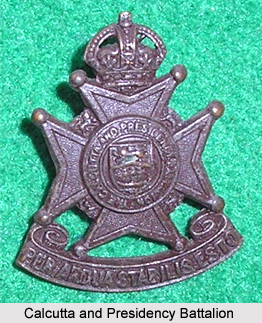 The Calcutta and Presidency Battalion was one of the infantry regiments that served under administrative authority of the British Colonial Auxiliary Forces of British Indian Army. It was formed by the British Empire in India on 23rd July 1926. The volunteer corps regiment was raised by the amalgamation of the Calcutta Battalion (Calcutta Volunteer Rifle Corps) and the Presidency Battalion (Presidency Volunteer Reserve Battalion). The Calcutta and Presidency Battalion was included as a part of the Bengal Army which was the military force of the Bengal Presidency. The army unit included 3 battalions from the Calcutta Battalion, Calcutta Presidency Battalion and the 3rd (Cadet) Battalion, Calcutta Volunteer Rifles.
The Calcutta and Presidency Battalion was one of the infantry regiments that served under administrative authority of the British Colonial Auxiliary Forces of British Indian Army. It was formed by the British Empire in India on 23rd July 1926. The volunteer corps regiment was raised by the amalgamation of the Calcutta Battalion (Calcutta Volunteer Rifle Corps) and the Presidency Battalion (Presidency Volunteer Reserve Battalion). The Calcutta and Presidency Battalion was included as a part of the Bengal Army which was the military force of the Bengal Presidency. The army unit included 3 battalions from the Calcutta Battalion, Calcutta Presidency Battalion and the 3rd (Cadet) Battalion, Calcutta Volunteer Rifles.
The headquarters of the Calcutta and Presidency Battalion was established Calcutta (now Kolkata) in West Bengal. The uniform of the troops was khaki formals for the 1st battalion and khaki drill for the 2nd battalion and the 3rd battalion. The uniform was later modified in the year 1940 and included khaki formal dress with white facings. The military badge included the Arms of Calcutta which was surmounted on crossed rifles.
This article is a stub. You may enrich it by adding more information to it. You can send your write-up at content@indianetzone.com



















